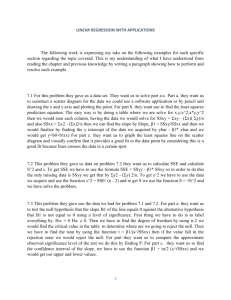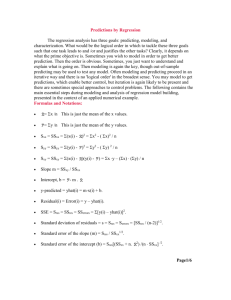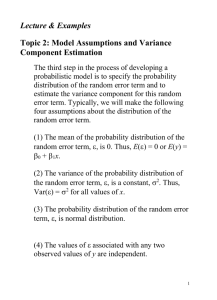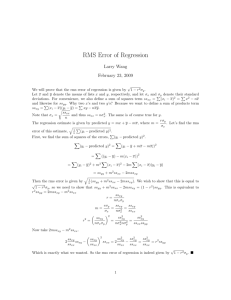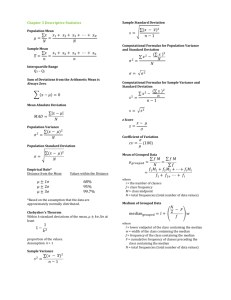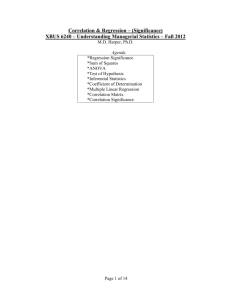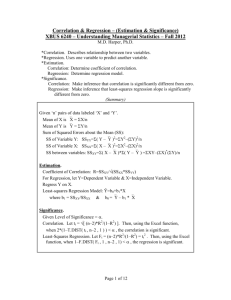Simple Linear Regression: Computational Aspects
advertisement
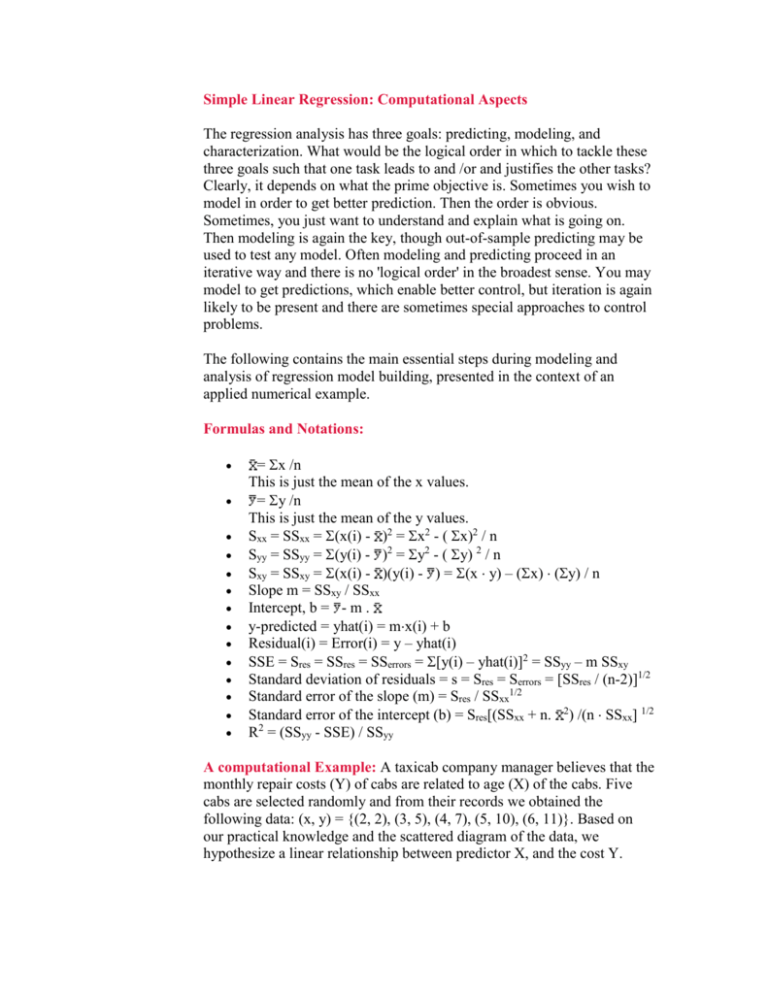
Simple Linear Regression: Computational Aspects
The regression analysis has three goals: predicting, modeling, and
characterization. What would be the logical order in which to tackle these
three goals such that one task leads to and /or and justifies the other tasks?
Clearly, it depends on what the prime objective is. Sometimes you wish to
model in order to get better prediction. Then the order is obvious.
Sometimes, you just want to understand and explain what is going on.
Then modeling is again the key, though out-of-sample predicting may be
used to test any model. Often modeling and predicting proceed in an
iterative way and there is no 'logical order' in the broadest sense. You may
model to get predictions, which enable better control, but iteration is again
likely to be present and there are sometimes special approaches to control
problems.
The following contains the main essential steps during modeling and
analysis of regression model building, presented in the context of an
applied numerical example.
Formulas and Notations:
= x /n
This is just the mean of the x values.
= y /n
This is just the mean of the y values.
Sxx = SSxx = (x(i) - )2 = x2 - (x)2 / n
Syy = SSyy = (y(i) - )2 = y2 - (y) 2 / n
Sxy = SSxy = (x(i) - )(y(i) - ) = (x y) – (x) (y) / n
Slope m = SSxy / SSxx
Intercept, b = - m .
y-predicted = yhat(i) = mx(i) + b
Residual(i) = Error(i) = y – yhat(i)
SSE = Sres = SSres = SSerrors = [y(i) – yhat(i)]2 = SSyy – m SSxy
Standard deviation of residuals = s = Sres = Serrors = [SSres / (n-2)]1/2
Standard error of the slope (m) = Sres / SSxx1/2
Standard error of the intercept (b) = Sres[(SSxx + n. 2) /(n SSxx] 1/2
R2 = (SSyy - SSE) / SSyy
A computational Example: A taxicab company manager believes that the
monthly repair costs (Y) of cabs are related to age (X) of the cabs. Five
cabs are selected randomly and from their records we obtained the
following data: (x, y) = {(2, 2), (3, 5), (4, 7), (5, 10), (6, 11)}. Based on
our practical knowledge and the scattered diagram of the data, we
hypothesize a linear relationship between predictor X, and the cost Y.
Now the question is how we can best (i.e., least square) use the sample
information to estimate the unknown slope (m) and the intercept (b)? The
first step in finding the least square line is to construct a sum of squares
table to find the sums of x values (x), y values (y), the squares of the x
values (x2), the squares of the x values (y2), and the cross-product of the
corresponding x and y values (xy), as shown in the following table:
SUM
x
y
x2
xy
y2
2
3
4
5
6
2
5
7
10
11
4
9
16
25
36
4
15
28
50
66
4
25
49
100
121
20
35
90
163
299
The second step is to substitute the values of x, y, x2, xy, and y2
into the following formulas:
SSxy = xy – (x)(y)/n = 163 - (20)(35)/5 = 163 - 140 = 23
SSxx = x2 – (x)2/n = 90 - (20)2/5 = 90- 80 = 10
SSyy = y2 – (y)2/n = 299 - 245 = 54
Use the first two values to compute the estimated slope:
Slope = m = SSxy / SSxx = 23 / 10 = 2.3
To estimate the intercept of the least square line, use the fact that the graph
of the least square line always pass through ( , ) point, therefore,
The intercept = b = – (m)( ) = (y)/ 5 – (2.3) (x/5) = 35/5 – (2.3)(20/5)
= -2.2
Therefore the least square line is:
y-predicted = yhat = mx + b = -2.2 + 2.3x.
After estimating the slope and the intercept the question is how we
determine statistically if the model is good enough, say for prediction. The
standard error of slope is:
Standard error of the slope (m)= Sm = Sres / Sxx1/2,
and its relative precision is measured by statistic
tslope = m / Sm.
For our numerical example, it is:
tslope = 2.3 / [(0.6055)/ (101/2)] = 12.01
which is large enough, indication that the fitted model is a"good" one.
You may ask, in what sense is the least squares line the"best-fitting"
straight line to 5 data points. The least squares criterion chooses the line
that minimizes the sum of square vertical deviations, i.e., residual = error
= y - yhat:
SSE = (y – yhat)2 = (error)2 = 1.1
The numerical value of SSE is obtained from the following computational
table for our numerical example.
x
Predictor
-2.2+2.3x
y-predicted
y
observed
error
y
squared
errors
2
3
4
5
6
2.4
4.7
7
9.3
11.6
2
5
7
10
11
-0.4
0.3
0
0.7
-0.6
Sum=0
0.16
0.09
0
0.49
0.36
Sum=1.1
Alternately, one may compute SSE by:
SSE = SSyy – m SSxy = 54 – (2.3)(23) = 54 - 52.9 = 1.1,
as expected
Notice that this value of SSE agrees with the value directly computed from
the above table. The numerical value of SSE gives the estimate of
variation of the errors s2:
s2 = SSE / (n -2) = 1.1 / (5 - 2) = 0.36667
The estimate the value of the error variance is a measure of variability of
the y values about the estimated line. Clearly, we could also compute the
estimated standard deviation s of the residuals by taking the square roots
of the variance s2.
As the last step in the model building, the following Analysis of Variance
(ANOVA) table is then constructed to assess the overall goodness-of-fit
using the F-statistics:
Analysis of Variance Components
Source
DF
Sum of
Squares
Mean
Square
Model
Error
Total
1
3
4
52.90000
SSE = 1.1
SSyy = 54
52.90000
0.36667
F Value
Prob > F
144.273
0.0012
For practical proposes, the fit is considered acceptable if the F-statistic is
more than five-times the F-value from the F distribution tables at the back
of your textbook. Note that, the criterion that the F-statistic must be more
than five-times the F-value from the F distribution tables is independent of
the sample size.
Notice also that there is a relationship between the two statistics that
assess the quality of the fitted line, namely the T-statistics of the slope and
the F-statistics in the ANOVA table. The relationship is:
t2slope = F
This relationship can be verified for our computational example.
The Coefficient of Determination: The coefficient of determination is
defined, and denoted by R2:
R2 = (SSyy - SSE) / SSyy = 1 – (SSE / SSyy),
0 R2 1
The numerical value of R2 represents the proportion of the sum of squares
of deviations of the y values about their mean that can be attributed to the
linear relationship between y and x.
For our numerical example, we have:
R2 = (SSyy - SSE) / SSyy = (54 – 1.1) / 54 = 0.98
This means that about 98% of variation in the house price is because the
houses have different sizes. Therefore, size of a house is a very strong
factor in prediction the price of the house by the constructed linear model
between size (x), and the price (y).
If sample size is large enough, say over 30 pairs of (x, y), then R2 has
stronger and more useful meaning. That is, the value of the R2 is the
percentage of variation in y that can be attributed to the variation in
predictor x to predict y by using the constructed linear model.
Predictions by Regression: After we have statistically checked the
goodness of-fit of the model and the residuals conditions are satisfied, we
are ready to use the model for prediction with confidence. Confidence
interval provides a useful way of assessing the quality of prediction. In
prediction by regression often one or more of the following constructions
are of interest:
1. A confidence interval for a single future value of Y corresponding
to a chosen value of X.
2. A confidence interval for a single pint on the line.
3. A confidence region for the line as a whole.
Confidence Interval Estimate for a Future Value: A confidence
interval of interest can be used to evaluate the accuracy of a single (future)
value of y corresponding to a chosen value of X (say, X0). This provides
confidence interval for an estimated value Y corresponding to X0 with a
desirable confidence level 1 - .
Yp Se . tn-2, /2 {1/n + (X0 – )2/ Sx}1/2
Confidence Interval Estimate for a Single Point on the Line: If a
particular value of the predictor variable (say, X0) is of special importance,
a confidence interval on the value of the criterion variable (i.e. average Y
at X0) corresponding to X0 may be of interest. This provides confidence
interval on the estimated value of Y corresponding to X0 with a desirable
confidence level 1 - .
Yp Se . tn-2, /2 { 1 + 1/n + (X0 – )2/ Sx}1/2
It is of interest to compare the above two different kinds of confidence
interval. The first kind has larger confidence interval that reflects the less
accuracy resulting from the estimation of a single future value of y rather
than the mean value computed for the second kind confidence interval.
The second kind of confidence interval can also be used to identify any
outliers in the data.
Confidence Region the Regression Line as the Whole: When the entire
line is of interest, a confidence region permits one to simultaneously make
confidence statements about estimates of Y for a number of values of the
predictor variable X. In order that region adequately covers the range of
interest of the predictor variable X; usually, data size must be more than
10 pairs of observations.
Yp Se { (2 F2, n-2, ) . [1/n + (X0 – )2/ Sx]}1/2
In all cases the JavaScript provides the results for the nominal (x) values.
For other values of X one may use computational methods directly,
graphical method, or using linear interpolations to obtain approximated
results. These approximation are in the safe directions i.e., they are
slightly wider that the exact values.
